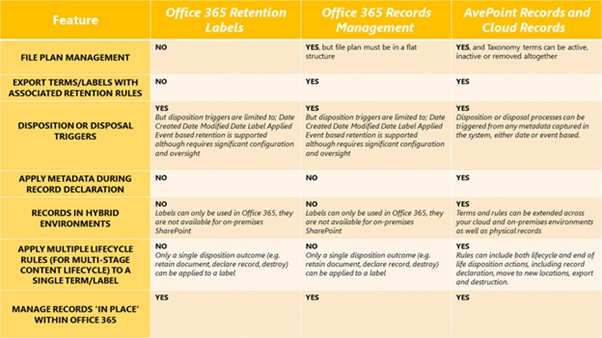In-Place vs. Out-of-Place: The Records Management Debate

SharePoint has been a great collaboration platform for many organizations. You can easily create dynamic websites with modern, fresh templates. It’s also a great space to post and announce news to keep your team in-the-know and updated. However, beyond these great collaboration features, did you know that SharePoint can also be a great platform to manage your records?
In the early years of SharePoint (out-of-place management for example) a records centre was the only way to manage your records. Using this method, you would need to create a specific site to place all your records. You could forward your records to this site and enforce the retention when it reached this out-of-place location.
Records placed in the record centre site were tagged with metadata or key information about the item, which was beneficial in managing the information and being able to easily recover it when needed.
However, Microsoft has dramatically changed their approach to records management and there is now a different method called in-place management.
Unlike in out-of-place systems where you have a specific space to archive your records, in this type of record management you can place and manage your records across multiple sites. All records regardless of where they live can be managed with in-place management.
You can also store and manage your records along with active documents, essentially removing the traditional definitions of “documents” vs “records.”
To do this, Microsoft introduced retention labels to manage the retention, disposal, or record declaration of content. This new function replaces building a Records Center or the out-of-place method.
However, you can still create and use records centres alongside retention labels. Retention labels can be implemented in all your content across your Microsoft 365 environment. You can read more about retention labels in this article.
Certainly, the new retention labels for in-place management represent a big shift in traditional records management and might even be considered easier to use compared to having a separate records centre. However, beyond the great things it can do, there are limitations that you might want to consider.
AvePoint’s Cloud Records is a great third-party solution for records management that goes beyond the capability of native retention in Microsoft 365. Let’s see some of the differences of what these records management systems can do so you can see what the best fit for your business needs could be.

In the table above we can see some of the limitations of the native records management and retention labels in Office and how third-party record management solutions like AvePoint Cloud Records could bridge those gaps.
Managing the records of your organization can be made much easier through the solutions we’ve mentioned here. You can either create a record centre, enforce In-place records management through retention labels, use both methods, or adapt third-party solutions.
However, the best way to decide which one is best for your situation is by analysing what the requirements of your organization are and what aligns with the needs of your business, your users, and your company’s compliance requirements.
Originally published at https://www.avepoint.com/blog/manage/records-management-debate/
